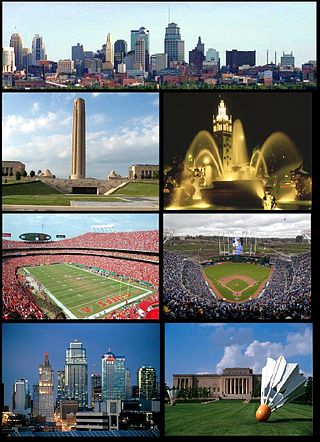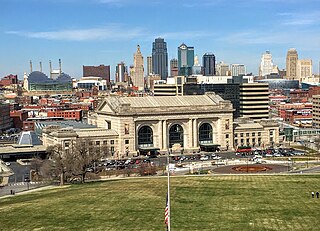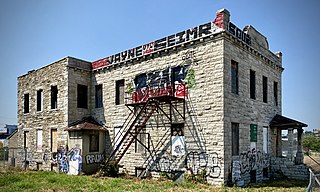
Kansas City, Missouri is the largest city in the U.S. state of Missouri by population and area. Most of the city lies within Jackson County, and other portions spill into Clay, Platte, and Cass counties. It is the central city of the Kansas City metropolitan area, which straddles the Missouri–Kansas state line and has a population of 2,392,035. As of the 2020 census, the city had a population of 508,090, making it the 37th most-populous city in the United States, as well as the sixth-most populous city in the Midwest. Kansas City was founded in the 1830s as a port on the Missouri River at its confluence with the Kansas River from the west. On June 1, 1850, the town of Kansas was incorporated; shortly after came the establishment of the Kansas Territory. Confusion between the two ensued, and the name Kansas City was assigned to distinguish them soon after.

Music of Missouri has a storied musical history. Missouri has had major developments in several popular music genres and has been the birthplace or career origin of many musicians. St. Louis was an important venue for early blues, jazz, country, and bluegrass. Kansas City has had famous performers such as Charlie Parker, Count Basie, Lester Young, and the distinct style of Kansas City jazz. Ragtime made influence in the city of Sedalia, Missouri, due to Scott Joplin and his publisher John Stark, and through Missouri native James Scott.

The Kansas City metropolitan area is a bi-state metropolitan area anchored by Kansas City, Missouri. Its 14 counties straddle the border between the U.S. states of Missouri and Kansas. With 8,472 square miles (21,940 km2) and a population of more than 2.2 million people, it is the second-largest metropolitan area centered in Missouri and is the largest metropolitan area in Kansas, though Wichita is the largest metropolitan area centered in Kansas. Alongside Kansas City, Missouri, these are the suburbs with populations above 100,000: Overland Park, Kansas; Kansas City, Kansas; Olathe, Kansas; Independence, Missouri; and Lee's Summit, Missouri.

The U Street Corridor or Greater U Street, sometimes known as Cardozo/Shaw, is a neighborhood in Washington, D.C., located in Northwest D.C. Centered along U Street, the neighborhood is one of Washington's most popular nightlife and entertainment districts, as well as one of the most significant African American heritage districts in the country.

Downtown Kansas City is the central business district (CBD) of Kansas City, Missouri and the Kansas City metropolitan area which contains 3.8% of the area's employment. It is between the Missouri River in the north, to 31st Street in the south; and from the Kansas–Missouri state line eastward to Bruce R. Watkins Drive as defined by the Downtown Council of Kansas City; the 2010 Greater Downtown Area Plan formulated by the City of Kansas City defines the Greater Downtown Area to be the city limits of North Kansas City and Missouri to the north, the Kansas–Missouri state line to the west, 31st Street to the south and Woodland Avenue to the east. However, the definition used by the Downtown Council is the most commonly accepted.

The Negro Leagues Baseball Museum (NLBM) is a privately funded museum dedicated to preserving the history of Negro league baseball in America. It was founded in 1990 in Kansas City, Missouri, in the historic 18th & Vine District, the hub of African-American cultural activity in Kansas City during the first half of the 20th century. The NLBM shares its building with the American Jazz Museum.

The architecture of Kansas City encompasses the metropolitan area, anchored by Kansas City, Missouri (KCMO). Major buildings by some of the world's most distinguished architects and firms include McKim, Mead and White; Jarvis Hunt; Wight and Wight; Graham, Anderson, Probst and White; Hoit, Price & Barnes; Frank Lloyd Wright; the Office of Mies van der Rohe; Barry Byrne; Edward Larrabee Barnes; Harry Weese; and Skidmore, Owings & Merrill.
Henry Perry was an American chef and restaurateur. He is widely considered the "Father of Kansas City barbecue."

Ward Parkway is a boulevard in Kansas City, Missouri, United States. Ward Parkway begins at Brookside Boulevard on the eastern edge of the Country Club Plaza and travels west 2.8 miles along Brush Creek as U.S. Route 56 before turning south near Kansas-Missouri state line. It continues south for 4 miles, terminating at Wornall Road near Bannister Road. A short spur, Brush Creek Parkway, connects Ward Parkway to Shawnee Mission Parkway at State Line Road.

Indiana Avenue is a historic area in downtown and is one of seven designated cultural districts in Indianapolis, Indiana. Indiana Avenue was, during its glory days, an African American cultural center of the area. The Indiana Avenue Historic District within the area was designated a United States national historic district in 1987.

LaSalle Park is an integral part of the three-neighborhood "Old Frenchtown" area—LaSalle Park, Lafayette Square and Soulard—bordering the southern edge of downtown St. Louis. It was formed as a "new" neighborhood, legally distinct from the larger Soulard district, through the efforts of the city of St. Louis, Missouri and Ralston Purina, which has its world headquarters in LaSalle Park.

The Paseo is a major north–south parkway in Kansas City, Missouri. As the city's first major boulevard, it runs approximately 10 miles (16 km) through the center of the city: from Cliff Drive and Lexington Avenue on the bluffs above the Missouri River in the Pendleton Heights historic neighborhood, to 85th Street and Woodland Avenue. The parkway holds 223 acres (0.90 km2) of boulevard parkland dotted with several Beaux-Arts-style decorative structures and architectural details maintained by the city's Parks and Recreation department.
Main Street or Main is one of the major streets in Kansas City, Missouri and the Kansas City metropolitan area. Main Street serves as the main administrative dividing line for house numbering and east–west streets in Kansas City; for example, it separates East 59th Street from West 59th Street. Address numbers on east–west streets increase in both directions as one moves away from Main Street. This should not be confused with the Kansas City "East Side" and "West Side," a cultural distinction which has arisen from a history of racist segregation in the city, separated by Troost Avenue approximately 1 mile east of Main Street.
Prospect Avenue is one of the major north-south streets in Kansas City, Missouri and the Kansas City metropolitan area. It begins in the north at E Reservoir Drive in the Pendleton Heights neighborhood of the Historic Northeast and stretches south for 10.5 miles to its southern terminus at Blue River Road. It runs closely parallel to U.S. Route 71 from Swope Parkway to 75th Street.

Troost Avenue is one of the major streets in Kansas City, Missouri and the Kansas City metropolitan area. Its northern terminus is at 4th Street and its southern terminus Bannister Road, totaling 10.7 miles (17.2 km). It is named after Kansas City's first resident physician, Benoist Troost.

The KC Streetcar is in Downtown Kansas City, Missouri. Streetcar system construction began in May 2014 and opened for service on May 6, 2016. It is free to ride, as it is funded by a transportation development district. As of June 2024, the streetcar has had 14 million rides since opening in 2016. Extensions north to the riverfront and south to University of Missouri-Kansas City have been funded, with both extensions currently under construction.

City workhouse castle is a city historical register site located at 2001 Vine Street in Kansas City, Missouri. The castle was constructed by contractors in 1897 for US$25,700 next to the natural deposit of yellow limestone which had been quarried by inmates of the preceding city workhouse jail across Vine Street. On December 20, 1897, the castle was inaugurated as the city's new workhouse with dedicated jail. Its Romanesque Revival architecture with castellated towers were in vogue among the Kansas City upper class at the time. Its first Superintendent, Major Alfred Brant, proudly declared it "the best building Kansas City has".

Quinton Donald Lucas is an American politician serving as the 55th mayor of Kansas City, Missouri. He was elected in 2019. A member of the Democratic Party, he is the city's third African-American mayor. Before his election, Lucas was a private practice lawyer, community leader, city council member, and a lecturer on law at Washington University. He was also a volunteer instructor at prisons in New York and Kansas, where he taught courses on constitutional law.

Wheatley-Provident Hospital is a historic site at 1826 Forest Avenue in the 18th and Vine District of Kansas City, Missouri. It was founded in 1902 and became Kansas City's first hospital for Black people.



















